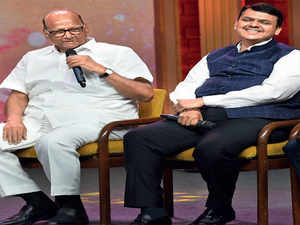
From a position where matters appeared done and dusted, the party has suffered a somewhat loss of face. The embarrassment comes despite —or, perhaps, because of — being the single-largest party, and in a position where it should have easily formed government with its pre-poll ally, Shiv Sena.
This is possibly the first instance of an electoral alliance breaking up, or at least being on the verge of divorce (remember George Fernandes’ volte-face in 1979?), after the partners jointly secured majority.
Party leaders will blame the usual suspects: a long-reckless partner, driven by a devil-may-care attitude; hubris of former chief minister Devendra Fadnavis; multiple local issues, which accentuated the popular economic discontent heard during campaigning….
Lok Sabha Elections#Elections With 
- All
- Uttar Pradesh
- Maharashtra
- Tamil Nadu
- West Bengal
- Bihar
- Karnataka
- Andhra Pradesh
- Telangana
- Kerala
- Madhya Pradesh
- Rajasthan
- Delhi
- Other States
But there’s a deeper malaise in BJP, its strategy, and the attitude of its leaders. Symptoms are not restricted to Maharashtra. They were in evidence in Haryana too, another state where BJP performance was under par. While some causes behind the setback have similarities, there are certain reasons unique to each state. Not recognising India’s political diversity could spell trouble for BJP in forthcoming state polls, starting with Jharkhand and Delhi.
In 2014, BJP formed governments in Maharashtra, Haryana and, subsequently, Jharkhand by successfully forging new social coalitions. In these three states, the BJP appointed CMs from non-dominant social groups — a brahmin in Maharashtra (against dominant Marathas), a khatri in Haryana (not a Jat), and in Jharkhand, Raghubar Das became the first non-tribal to head the state government.
A similar strategy was tried out, specially among dalits and other backward classes (OBCs) in Uttar Pradesh, where the party’s 2017 victory was aided considerably by securing the support of non-jatavs within dalits and non-yadavs among backward castes. In UP, this remained confined to electoral strategy.
But in other states, it resulted in dominant communities having to yield political power. So, it wasn’t long before governments in Maharashtra and Haryana faced agitations by dominant communities on the emotive issue of reservations.
By the time of the 2019 Lok Sabha polls, agitations had been quelled, and it seemed that these communities had also begun backing BJP. The election verdict suggested that BJP had pulled off the gambit. But as Maharashtra and Haryana show, the party’s strategy has not gone down well with Marathas and Jats, who now want a larger share of the pie.
As it is, the Sangh Parivar bears the reputation of being pro-brahmin, always an impediment to its Hindu consolidation. BJP forged a new social coalition after the 2014 elections. But there seems to be a need now to reconsider matters.
This, however, carries the danger of discontent from the earlier propped-up non-dominant castes, with the risk of them shifting support. As of now, such dissatisfaction is unlikely to be evident because of PM Modi’s popularity, and his knack for throwing in issues pertaining to national security and ‘pride’ at the right moments.
The ‘Modi factor’ ensured in 2014 and 2019 that Lok Sabha elections no longer remained aggregations of electoral contests. Yet, issues that crop up during assembly and parliamentary elections are now distinctly different. This alone explains why BJP’s fortunes changed barely five months after its stunning May victory.
BJP possibly failed to factor in the changed scenario after its reelection in May — that for state polls, voters will now on make up their minds chiefly on the basis of the performance of state governments, local issues and economic concerns.
Although the party’s national leadership focused on national issues like its decision on Article 370, voters did not overwhelmingly line up behind the party in Haryana and Maharashtra.
Personal financial security does weigh heavily on people’s minds, especially when the nation is in ‘safe’ hands. BJP can’t become oblivious to its 1991 slogan of ‘Ram and Roti’, formulated with the intention of appealing to a religionationalist sentiment while linking this to people’s livelihood concerns.
In the winter of 2017, BJP barely managed to salvage prestige in Gujarat. Thereafter, it lost Madhya Pradesh, Rajasthan and Chhattisgarh. These were the first states after Modi assumed office where BJP was not a challenger, but the incumbent. As the party in power in most states, it can no longer play the ‘memory card’ — reminding people of adversaries’ kushasan (misrule).
In states, BJP’s hopes will depend on its performance, even the Centre’s. To retain states, the party will have to unlearn tactics that served swashbuckling ‘invaders’ well. Instead, it needs to learn and master ways of safeguarding bastions. On its part, the government has to recognise disquiet, before it turns into resentment.
Read More News on
Download The Economic Times News App to get Daily Market Updates & Live Business News.
Subscribe to The Economic Times Prime and read the ET ePaper online.
Read More News on
Download The Economic Times News App to get Daily Market Updates & Live Business News.
Subscribe to The Economic Times Prime and read the ET ePaper online.













 Get Unlimited Access to The Economic Times
Get Unlimited Access to The Economic Times
